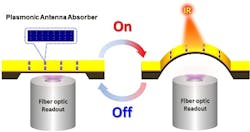Nanoantennas improve optomechanical thermal IR sensing
(Image: University of Pennsylvania)
Philadelphia, PA--A team of University of Pennsylvania engineers has created a pattern of nanoantennas that turn infrared light into mechanical action, which could lead to more-sensitive infrared (IR) cameras.
“We set out to make an optomechanical thermal infrared detector,” says Ertugrul Cubukcu, one of the researchers. “Rather than changes in resistance, our detector works by connecting mechanical motion to changes in temperature.”
The advantage to this approach is that it could reduce the footprint of an IR-sensing device to something that would fit on a disposable silicon chip. The researchers fabricated such a device in their study.
At the core of the device is a nanoscale structure about 0.1 x 0.5 mm in overall size and made of a layer of gold bonded to a layer of silicon nitride. The researchers chose these materials because of their different thermal-expansion coefficients. Because metals will naturally convert some energy from IR light into heat, researchers can connect the amount the material expands to the amount of IR light hitting it.
“A single layer would expand laterally, but our two layers are constrained because they’re attached to one another,” Cubukcu says. “The only way they can expand is in the third dimension. In this case, that means bending toward the gold side, since gold has the higher thermal-expansion coefficient.”
To measure this movement, the researchers used a fiber interferometer in which light exiting a fiber-optic cable is bounced off the underside of the silicon nitride layer, enabling the researchers to determine how far the structure has bent upwards. “We can even see displacements that are thousands of times smaller than a hydrogen atom,” says Cubukcu.
High efficiency due to nanoantennas
Other researchers have developed optomechanical IR sensors based on this principle, but their sensitivities have been comparatively low. The Penn team’s device is an improvement in this regard due to the inclusion of “slot” plasmonic nanoantennas, which are cavities etched into the gold layer at intervals that correspond to wavelengths of mid-IR light, and which boost the conversion efficiency of the detector by a factor of ten.
“Other techniques can only work at the maximum absorption determined by the material itself,” says Fei Yi, another researcher. “Our antennas can be engineered to absorb at any wavelength.”
While only a proof-of-concept at this stage, future research may demonstrate the device’s capabilities as a low-cost way of analyzing individual proteins and gas molecules.
The research was published in the journal Nano Letters.
